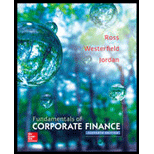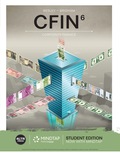
Fundamentals of Corporate Finance
11th Edition
ISBN: 9780077861704
Author: Stephen A. Ross Franco Modigliani Professor of Financial Economics Professor, Randolph W Westerfield Robert R. Dockson Deans Chair in Bus. Admin., Bradford D Jordan Professor
Publisher: McGraw-Hill Education
expand_more
expand_more
format_list_bulleted
Concept explainers
Question
Chapter 16, Problem 7QP
Summary Introduction
To compute: The price for one share of equity under Plan I and Plan II and the principle that is illustrated in the computation.
Introduction:
The leverage refers to the borrowing of amount or debt to utilize for a purchase of an equipment, inventory, and other assets of the company.
Expert Solution & Answer
Want to see the full answer?
Check out a sample textbook solution
Students have asked these similar questions
What is the marketing communication budget plan for this types of campaign (not specific, can be general amount in peso):
• Television Commercial
• Radio
• In-store/banner/billboards
• Publication Materials for Facebook and Instagram
• Reels/TikTok Videos
• GIF
• Marathon
• Campus Caravan
• E-Vouchers
• Deals Offer
Considering a 60 million pesos budget for one year. Please cite references.
What is the amount of budget that could be provided using these advertisements?
(not specific, can be general amount in peso):
• Television Commercial
• Radio
• In-store/banner/billboards
• Publication Materials for Facebook and Instagram
• Reels/TikTok Videos
• GIF
• Marathon
• Campus Caravan
• E-Vouchers
• Deals Offer
Please cite references.
What is a blue-chip stock?
a) A stock with high volatilityb) A stock of a well-established, financially sound companyc) A newly launched IPO stockd) A stock with high dividends but low growth no ai
Chapter 16 Solutions
Fundamentals of Corporate Finance
Ch. 16.1 - Why should financial managers choose the capital...Ch. 16.1 - What is the relationship between the WACC and the...Ch. 16.1 - What is an optimal capital structure?Ch. 16.2 - Prob. 16.2ACQCh. 16.2 - Prob. 16.2BCQCh. 16.2 - Prob. 16.2CCQCh. 16.3 - What does MM Proposition I state?Ch. 16.3 - What are the three determinants of a firms cost of...Ch. 16.3 - Prob. 16.3CCQCh. 16.4 - What is the relationship between the value of an...
Ch. 16.4 - If we consider only the effect of taxes, what is...Ch. 16.5 - Prob. 16.5ACQCh. 16.5 - What are indirect bankruptcy costs?Ch. 16.6 - Can you describe the trade-off that defines the...Ch. 16.6 - What are the important factors in making capital...Ch. 16.7 - Prob. 16.7ACQCh. 16.7 - What is the difference between a marketed claim...Ch. 16.7 - What does the extended pie model say about the...Ch. 16.8 - Prob. 16.8ACQCh. 16.8 - Why might firms prefer not to issue new equity?Ch. 16.8 - Prob. 16.8CCQCh. 16.9 - Do U.S. corporations rely heavily on debt...Ch. 16.9 - What regularities do we observe in capital...Ch. 16.10 - Prob. 16.10ACQCh. 16.10 - Prob. 16.10BCQCh. 16 - Maximizing what will maximize shareholder value?Ch. 16 - What is most closely related to a firms use of...Ch. 16 - Give an example of a direct cost of bankruptcy.Ch. 16 - Prob. 16.7CTFCh. 16 - Prob. 1CRCTCh. 16 - Prob. 2CRCTCh. 16 - Optimal Capital Structure [LO1] Is there an easily...Ch. 16 - Observed Capital Structures [LO1] Refer to the...Ch. 16 - Financial Leverage [LO1] Why is the use of debt...Ch. 16 - Homemade Leverage [LO1] What is homemade leverage?Ch. 16 - Prob. 7CRCTCh. 16 - Prob. 8CRCTCh. 16 - Prob. 9CRCTCh. 16 - Prob. 10CRCTCh. 16 - Prob. 1QPCh. 16 - Prob. 2QPCh. 16 - Prob. 3QPCh. 16 - Prob. 4QPCh. 16 - MM and Stock Value [LO1] In Problem 4, use MM...Ch. 16 - Prob. 6QPCh. 16 - Prob. 7QPCh. 16 - Prob. 8QPCh. 16 - Homemade Leverage and WACC [LO1] ABC Co. and XYZ...Ch. 16 - Prob. 10QPCh. 16 - MM and Taxes [LO2] In the previous question,...Ch. 16 - Calculating WACC [LO1] Twice Shy Industries has a...Ch. 16 - Calculating WACC [LO1] Braxton Corp. has no debt...Ch. 16 - MM and Taxes [LO2] Meyer Co. expects its EBIT to...Ch. 16 - Prob. 15QPCh. 16 - MM [LO2] Tool Manufacturing has an expected EBIT...Ch. 16 - Prob. 17QPCh. 16 - Homemade Leverage [LO1] The Day Company and the...Ch. 16 - Weighted Average Cost of Capital [LO1] In a world...Ch. 16 - Cost of Equity and Leverage [LO1] Assuming a world...Ch. 16 - Business and Financial Risk [LO1] Assume a firms...Ch. 16 - Stockholder Risk [LO1] Suppose a firms business...Ch. 16 - Prob. 1MCh. 16 - Prob. 2MCh. 16 - Prob. 3MCh. 16 - Stephenson Real Estate Recapitalization Stephenson...Ch. 16 - Stephenson Real Estate Recapitalization Stephenson...
Knowledge Booster
Learn more about
Need a deep-dive on the concept behind this application? Look no further. Learn more about this topic, finance and related others by exploring similar questions and additional content below.Similar questions
- What is a blue-chip stock? a) A stock with high volatilityb) A stock of a well-established, financially sound companyc) A newly launched IPO stockd) A stock with high dividends but low growth need help!arrow_forwardWhat is a blue-chip stock? a) A stock with high volatilityb) A stock of a well-established, financially sound companyc) A newly launched IPO stockd) A stock with high dividends but low growtharrow_forwardNeed help in this question !properly What does “liquidity” refer to in finance? a) The profitability of a companyb) The ease of converting assets into cashc) The stability of incomed) The level of debtarrow_forward
- I need help in this question! What does “liquidity” refer to in finance? a) The profitability of a companyb) The ease of converting assets into cashc) The stability of incomed) The level of debtarrow_forwardDont use chatgpt and give answer What does “liquidity” refer to in finance? a) The profitability of a companyb) The ease of converting assets into cashc) The stability of incomed) The level of debtarrow_forwardThe opportunity cost of holding cash is inversely related to the level of market interest rates. Question 9 options: True Falsearrow_forward
- Your firm deals strictly with four customers. The average amount that each customer pays per month along with the collection delay associated with each payment is shown below. Given this information, what is the amount of the average daily receipts? Assume that every month has 30 days. Customer Item Amount Delay A $8,500 5 days B $12,000 2 days C $16,000 3 days D $3,600 2 days Question 8 options: $8,448 $1,337 $3,342 $1,408 $10,025arrow_forwardWhich of the following is true regarding cash management? Question 7 options: The basic objective in cash management is to keep the investment in cash as low as possible while still operating efficiently and effectively. Effective cash management results in minimization of the total interest earnings involved with holding cash. A cost of holding cash is the liquidity it gives the firm. A firm should decrease its cash holdings as long as the NPV of doing so is negative. A cost of holding cash is the interest income earned on the outstanding cash balance.arrow_forwardLow default risk is a characteristic of money market securities. Question 6 options: True Falsearrow_forward
- Jeep Corp. held large sums of cash during the mid-1990s primarily because it would need a large amount of cash in the event of a recession. This is a[n] _____ for holding cash. Question 5 options: Adjustment motive. Compensating balances motive. Speculative motive. Transactions motive. Precautionary motive.arrow_forwardWith respect to the workings of a lockbox system, the cheque clearing process begins before the company even knows the payments have been received. Question 4 options: True Falsearrow_forwardYou are considering implementing a lockbox system for your firm. The system is expected to reduce the collection time by 1.5 days. On an average day, your firm receives 250 checks with an average value of $400 each. The daily interest rate on Treasury bills is .02%. What is the anticipated amount of the daily savings if this system is implemented? Question 3 options: $30 $25 $15 $20 $10arrow_forward
arrow_back_ios
SEE MORE QUESTIONS
arrow_forward_ios
Recommended textbooks for you

 Intermediate Financial Management (MindTap Course...FinanceISBN:9781337395083Author:Eugene F. Brigham, Phillip R. DavesPublisher:Cengage Learning
Intermediate Financial Management (MindTap Course...FinanceISBN:9781337395083Author:Eugene F. Brigham, Phillip R. DavesPublisher:Cengage Learning


Intermediate Financial Management (MindTap Course...
Finance
ISBN:9781337395083
Author:Eugene F. Brigham, Phillip R. Daves
Publisher:Cengage Learning

Dividend disocunt model (DDM); Author: Edspira;https://www.youtube.com/watch?v=TlH3_iOHX3s;License: Standard YouTube License, CC-BY